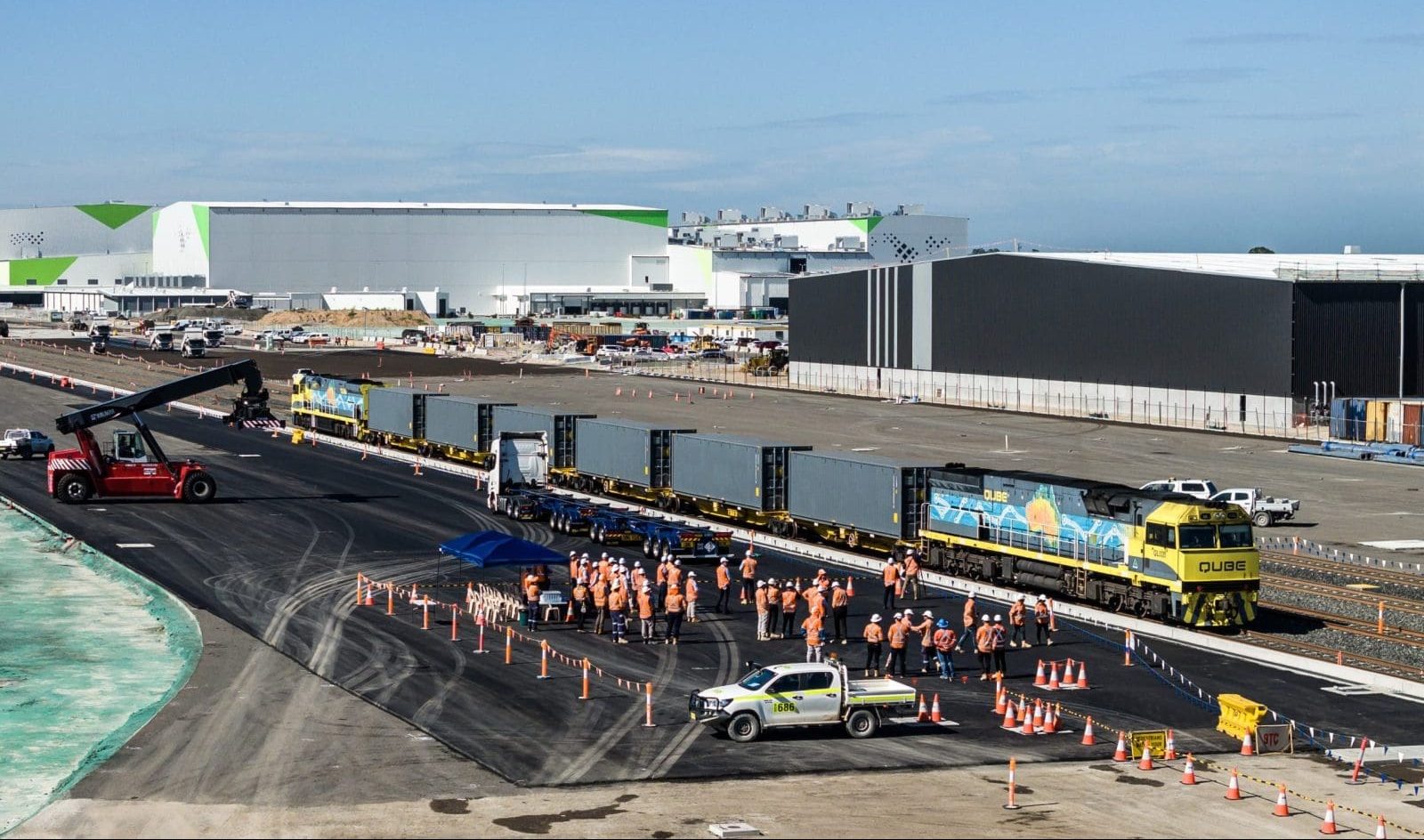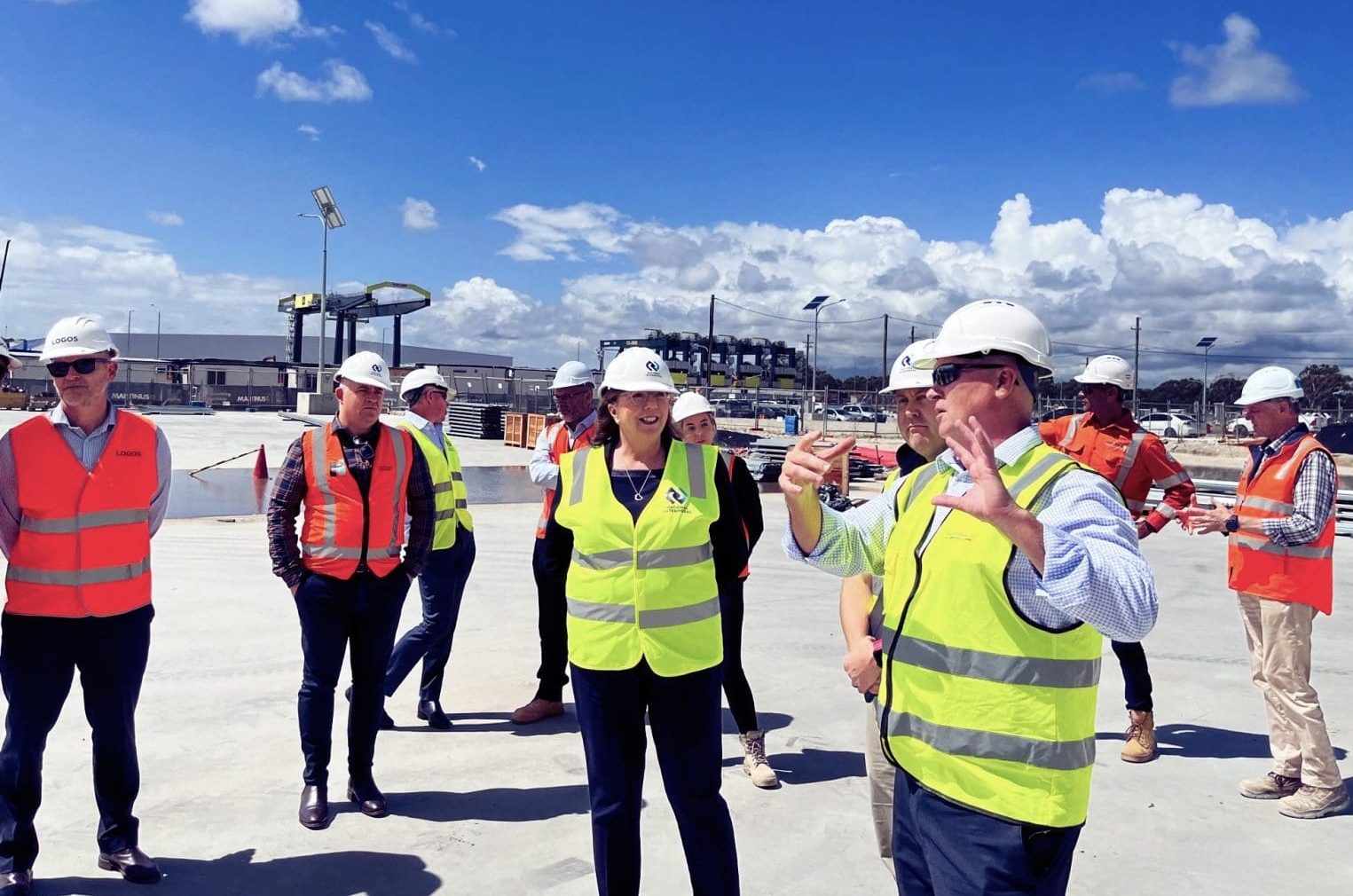
Qube recently tested trains through the Moorebank Interstate Terminal which is currently under construction. Photo: Qube
THE NEW interstate rail terminal at Moorebank in Sydney’s south-west is on track for commissioning in April, according to logistics company Qube.
The terminal is part of the Moorebank Logistics Park, a 240ha site which also includes an already operational rail link to Port Botany, warehouses and road links.
It is owned by a consortium led by property investor Logos Property Group, with the rail component managed by Qube in conjunction with Australian Government-owned National Intermodal.
When completed, it is envisioned that the interstate terminal and adjoining intermodal freight facilities will improve the movement of container freight by rail between Port Botany and south-western Sydney.
Qube last month successfully tested the first train through the terminal.
“We recently ran a test train into the terminal and this proved very successful, with the train carrying six containers seamlessly moving through the terminal,” a spokesperson for Qube said.
“On that basis, we remain confident that we will meet the revised delivery timetable we announced at our full-year results in August 2023 and look to be on track for completion and commissioning of the new terminal in April.”
Port Botany is Australia’s second-largest container and handles one-third of the country’s container volumes.
It is the point of export for much of the state’s containerised cotton, grain, meat, oilseeds and pulses.
According to NSW Farmers, approximately 40 percent of grain exports from NSW are containerised.
Rail currently accounts for only 11pc of the total freight task across the east coast, and as little as 2pc on the corridor between Melbourne and Sydney.
“The interstate will be a welcome addition to the Moorebank precinct, creating significant freight efficiencies between interstate capitals and further strengthening supply linkages for customers to warehousing and other facilities, and of course to Port Botany,” the Qube spokesperson said.
“Once complete, the terminal will be capable of processing 1800m long interstate trains, each removing the equivalent of approximately 120 trucks of freight and consumer goods from the road network.
“All up, the initial development will have capacity of 250,000 TEUs and be able to process around 1000 trains per year.
“The ultimate design capacity of the terminal is for 2000 trains and 500,000 TEUs per annum.”
In a statement Infrastructure, Transport, Regional Development and Local Government Minister Catherine King said the terminal would complement the freight enhancements in the national network, including Inland Rail.
“This project will significantly enhance the resilience of Australia’s supply chain, while providing thousands of local jobs and reducing transport emissions,” Ms King said.
“It will also support more competitive freight costs, reduce traffic congestion, increase road safety and deliver better environmental outcomes.”

Infrastructure Minister Catherine King visited the Moorebank precinct last year. Photo: Catherine King
Impacts on farmers
It is hoped the terminal will have some impact on the flow of containerised agricultural commodities from rural areas to port.
Recently, farming organisations have supported the concept of container operations to the Port of Newcastle as most efficient solution to the bottlenecking of freight at Botany.
With the movement towards building a container terminal at Newcastle, this could be viable option.
However, the Moorebank terminal and adjoining infrastructure could be an interim measure and would operate in tandem with the Port of Newcastle facilities if successful.
In a submission to a recent review into Port Botany’s landside operations, NSW Farmers said major changes need to be made to rail freight flows into the port.
“It is of significant concern that congestion in and around ports is where bottlenecks occur, not necessarily at the port loading facilities themselves,” the submission said.
“This is especially true at Port Botany, which requires trucks to travel through Sydney and can also only fit certain sized trains.
“Without significant improvement in the rail access to and operations at Port Botany…the current supply-chain challenges will increase over time and will reduce the competitiveness of NSW grain exports.”
National Intermodal chief executive officer James Baulderstone said Moorebank would “boost market confidence that higher volumes of rail freight can move efficiently, safely and sustainably across state borders”.
“The rail freight sector has been constrained by limited infrastructure investment and market concentration,” Mr Baulderstone said.
“The genuinely open access facilities at Moorebank will help to ensure that efficiency savings resulting from these modern facilities are passed onto customers and end consumers helping to relieve recent significant increases in supply chain costs.”
Warehouse progress
The consortium, Ivanhoé Cambridge, AustralianSuper, and TCorp (NSW Treasury Corporation) and AXA IM Alts alongside LOGOS, purchased the precinct from Qube in 2021 for around $1.6 billion.
Alongside the rail facilities, the precinct includes 850,000 square metres of warehousing.
Last year LOGOS confirmed over 162,000sqm of warehousing would be completed before the end of 2023 valued at $620M.
The company said about 50pc of the warehouse was leased, with shipping and logistics firm Maersk signing on as a tenant in November.
They will join existing leaseholders which include Mainfreight, Primary Connect and PCA Express.
Grain Central: Get our free news straight to your inbox – Click here



HAVE YOUR SAY